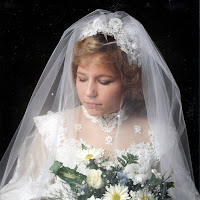The use of bridal veils as part of traditional attire for women dates all the way back to medieval times and has remained a tradition ever since. The history of the bridal veil does not have its roots in a place you would likely suspect; it started as a normal piece of attire that married women wore on a daily basis. Like all other traditions, the use of veils for daily use transitioned into only being worn on special occasions such as weddings. It’s not widely regarded as one of the latest wedding trends to wear a veil at your wedding, but there are many variations that are quite new to the scene. The full history and meaning being the bridal veil is important to understand and can make for a few fun trivia questions at your bridal shower.
Back in mediaeval times, a time when tradition was one of the most important parts of daily life, Anglo women wore veils as part of their daily attire. This separated the married women from the single women because an unmarried woman would typically not wear a veil; which would tip off would-be suitors that a woman was available for courtship. However, the veil also had a very practical purpose; covering a married woman’s hair, neck, and chin from the purview of other men. Additionally, the knitted mesh veils protected woman’s skin from wind and sun damage in a time that had few havens from the forces of nature. By the 15th century, the veil was replaced by hoods and the world was prepared to make bridal veils a new wedding tradition.
Wedding traditions in the mediaeval times were much different than they are today, and many of them were rooted in superstition or religious beliefs. Unlike the modern day, there weren’t a lot of options for a mediaeval wedding celebration. Things like veils were all that brides of that area had, so they really put as much care into their choices as possible.
In the 1900’s the bridal veil took a drastic change for the better when the wide loom and silk tulle allowed manufacturers to create much more lightweight and sheer designs. It also brought the cost of a veil down substantially, which meant they were much easier to afford and became even more widespread. The sheer look of the modern bridal veil enhanced a young woman’s attractiveness, and signified modesty, privacy, youth, and virginity. This significance is still prevalent in many wedding traditions today because only first-time brides typically wear a veil at their wedding.
As a final touch to your wedding dress that complements a woman’s individual beauty, the history of the bridal veil is just beginning to be written. Though it has become one of those items that simply appears at most weddings, there is no telling what new and exciting traditions will develop in the future. In fact, with a little creativity when you’re doing your shopping, you could be the next person to add a fun new twist to the timeless tradition of wearing a wedding veil.

No comments:
Post a Comment